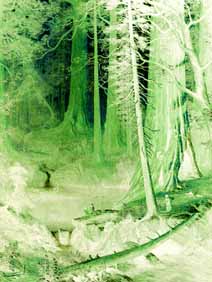|
|
|
|||
|
This morning I investigated an "Open House" sign across the street, and found an apartment for rent which seemed quite viable. Slightly smaller and cheaper than my own, and quieter. The drawbacks can be capsualized in a single word - Familiarity. All the buildings along my street are alike. Subtle differences in ornamentation distinguish buildings whose interiors all conform to an early 1960s design aesthetic when they were constructed, which is fine by me except it's what I've got now and I want something different - maybe from the same era, but not the identical stove, bathroom etc. Plus, although tolerable, when I go to the trouble of moving I want a new neighborhood also. And this unit is even closer to the screechy turbine ventilator. Later, after a hot turkey sandwich at Jim's Coffee Shop (a meal which is becoming a weekend tradition) I stumbled across the Palo Alto Farmers Market - I knew they had one, but I wasn't certain where. I bought a pound of yellow Rainer cherries - it's summer at last; cherries are in season! And soon, peaches! Later I wandered over to the Sushi House, and was disappointed. Last time I went it was closed for some minor remodeling; now that they've opened a change has been inaugurated which has ruined their charm: now instead of all customers paying first, "eating there"s are instructed to "take a seat" and wait for one of the new waitresses. After eating, more waiting for the waitress to bring the check, and then for your change. The old system was far superior; of course it made tipping optional but I always left something. Now they're just an inexpensive Japanese restaurant so I'm deleting their entry from my Places page. Art today, at Stanford. They've got a big building, a museum containing the Cantor Arts Center which has been closed for a decade due to a renovation triggered by earthquake damage, but recently reopened. I was there for an exhibition which I'll describe shortly, but I also learned about Stanford - the museum's named after Senator Leland Stanford's son, Leland Junior, who died of typhoid fever in Italy while touring Europe at age 16. A large portrait of him pictured with his elbow resting on a "...stunted column, a classical symbol of the death of a youth" is prominent in a room full of objects owned and collected by the Stanfords, such as a cannonball from Fort Sumter, a Megalethoscope, Junior's death mask, and an amazingly intricate relief carving of a crane (holding a worm in its beak) which he allegedly carved into a flat piece of wood at age 9. Supposedly on display used to be more of his toys (besides the one small steam engine I saw) - as a prank in the 1930s someone slipped a plate of bacon & eggs into a display case with a card labeled "Young Leland's Last Breakfast" which stayed there for years. This incident is now immortalized by a sculpture nearby - a breakfast made from ceramic materials on a wooden tray with this same name. But I was there for the "Pacific Arcadia" exhibition ("Images of California 1600-1915"). Two striking paintings worth mentioning were "The Fandango" (1873) by Charles Christian Nahl, a display of the Rancho fantasy; and "San Francisco at Night from Telegraph Hill" (1875) by Joachim Ferdinand Richardt. The latter was oddly familiar, it matched a vision of San Francisco I had often during around 1973, when I first began to wonder about what a view from the window of a residence in the City might be like. A quote on a wall stated that We spring to our feet and wave our hands while we sing "Hallelujah" as the doors of this heavenly city are thrown open to receive us.This image was the show's signature, on the folder and catalog - click it to view its original splendor. |

"Giant Redwood Trees of California" (inverted) |
|||
|
Rash June 5 © 1999 |
|
|
||